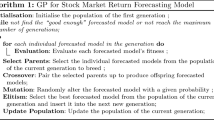Abstract
Traditional linear regression and time-series models often fail to produce accurate forecasts due to inherent nonlinearities and structural instabilities, which characterize financial markets and challenge the Efficient Market Hypothesis. Machine learning techniques are becoming widespread tools for return forecasting as they are capable of dealing efficiently with nonlinear modeling. An evolutionary programming approach based on genetic algorithms is introduced in order to estimate and fine-tune the parameters of the STAR-class models, as opposed to conventional techniques. Using a hybrid method we employ trading rules that generate excess returns for the Eurozone southern periphery stock markets, over a long out-of-sample period after the introduction of the Euro common currency. Our results may have important implications for market efficiency and predictability. Investment or trading strategies based on the proposed approach may allow market agents to earn higher returns.

Similar content being viewed by others
References
Abiyev, R. H., & Abiyev, V. H. (2012). Differential evaluation learning of fuzzy wavelet neural networks for stock price prediction. Journal Information Computational Science, 7(2), 21–130.
Arumugam, M. S., & Rao, M. V. C. (2008). On the improved performances of the partical swarm optimization algorithms with adaptive parameters, cross-over operators and root mean square (RMS) variants for computing optimal control of a class of hybrid systems. Applied Soft Computing, 8, 324–336.
Austin, M., Bates, G., Dempster, M., & Williams, S. (2004). Adaptive systems for foreign exchange trading. Eclectic, 18, 21–26.
Bäck, T. (1996). Evolutionary Algorithms in Theory and Practice. Oxford: Oxford University Press.
Bacon, D. W., & Watts, D. G. (1971). Estimating the transition between two intersecting straight lines. Biometrika, 58, 525–534.
Balke, N., & Fomby, T. (1994). Large shocks, small shocks, and economic fluctuations: Outliers in macroeconomic time series. Journal of Applied Econometrics, 9, 181–200.
Balvers, R. J., Cosimano, T. F., & McDonald, B. (1990). Predicting stock returns in an efficient market. Journal of Finance, 45, 1109–1128.
Bekiros, S. (2009). A Robust algorithm for parameter estimation in Smooth Transition Autoregressive models. Economics Letters, 103, 36–38.
Beller, K., & Nofsinger, J. R. (1998). On stock return seasonality and conditional heteroskedasticity. The Journal of Financial Research, 21, 229–246.
Bernhardt, D., Campello, D., & Kutsoati, E. (2006). Who herds. Journal of Financial Economics, 80, 657–676.
Bollerslev, T., & Ghysels, E. (1996). Periodic autoregressive conditional heteroskedasticity. Journal of Business and Economic Statistics, 14, 139–152.
Bradleya, M. D., & Jansen, D. W. (2004). Forecasting with a nonlinear dynamic model of stock returns and industrial production. International Journal of Forecasting, 20(2), 321–342.
Breen, W., Glosten, L. R., & Jagannathan, R. (1990). Predictable variations in stock index returns. Journal of Finance, 44, 1177–1189.
Brock, W. A., Dechert, D., & Scheinkman, J. (1987). A test for independence based on the correlation dimension’. University of Wisconsin-Madison, Social Science Research Working Paper, no. 8762.
Burridge, P., & Taylor, A. M. R. (1999). On Regression-based Tests for Seasonal Unit Roots in the Presence of Periodic Heteroskedasticity, Discussion Paper, No. 9910. Department of Economics, University of Birmingham.
Campbell, J. Y., & Hamao, Y. (1992). Predictable stock returns in the United States and Japan: A study of long term capital integration. Journal of Finance, 47, 43–67.
Chan, K., & Tong, H. (1986). On estimating thresholds in autoregressive models. Journal of Time Series Analysis, 7, 179–194.
Daniel, K., & Titman, S. (2006). Market reactions to tangible and intangible information. The Journal of Finance, 61, 1605–1643.
Diebold, F. X., & Mariano, R. S. (1995). Comparing predictive accuracy. Journal of Business and Economic Statistics, 13, 253–265.
De Lima, P. J. F. (1996). Nuisance parameter free properties of correlation integral based statistics. Econometric Reviews, 15, 237–259.
Ferson, W. E., & Harvey, C. R. (1993). The risk and predictability of international equity returns. Review of Financial Studies, 6, 527–566.
Franses, P., Van Dijk, D., & Lucas, A. (2004). Short patches of outliers, ARCH and volatility modelling. Applied Financial Economics, 14, 221–231.
Franses, P., & Van Dijk, D. (2000). Non-linear time series models in empirical finance. Cambridge: Cambridge University Press.
Glosten, L. R., Jagannathan, R., & Runkle, D. E. (1993). On the relation between the expected value and the volatility of the nominal excess return on stocks. Journal of Finance, 48, 1779–1801.
Granger, C. W. J., & Teräsvirta, T. (1993). Modelling nonlinear economic relationships. Oxford: Oxford University Press.
Hamilton, J. D. (1994). Time series analysis. Princeton: Princeton University Press.
Hendry, D. F. (1995). Dynamic econometrics. Oxford: Oxford University Press.
Hirschleifer, D., Subrahmanyam, A., & Titman, S. (2006). Feedback and the success of irrational investors. Journal of Financial Economics, 81, 311–338.
Leybourne, S., Newbold, P., & Vougas, D. (1998). Unit roots and smooth transitions. Journal of Time Series Analysis, 19, 83–97.
Majhi, R., Panda, G., Sahoo, G., Dash, P. K., & Das, D. P. (2007). Stock market prediction of S&P 500 and DJIA using bacterial foraging optimization technique. In: Evolutionary computation CEC 2007, IEEE congress, pp 2569-2575.
Miao, K., Chen, F., & Zhao, Z. G. (2007). Stock price forecast based on bacterial colony RBF neural network. Journal of Qingdao University (Natural Science Edition), 20(2), 50–54.
Mitchell, M. (1996). An introduction to genetic algorithms. Massachusetts: MIT Press Cambridge.
Nevmyvaka, Y., Feng, Y., & Kearns, M. (2006). Reinforcement learning for optimized trade execution. ICML ’06 in: Proceedings of the 23rd international conference on Machine learning. ACM Press, pp 673–680.
Newey, W. K., & West, K. D. (1994). Automatic lag selection in covariance matrix estimation. Review of Economic Studies, 61, 631–653.
Peralta, J., Li, X., Gutierrez, G., & Sanchis, A. (2010). Time series forecasting by evolving artificial neural networks using genetic algorithms and differential evolution. Proceedings of the International Joint Conference on Neural Networks (IJCNN ’10) 1-8, IEEE.
Pérez-Rodríguez, J. V., Torra, S., & Andrada-Félix, J. (2005). STAR and ANN models: forecasting performance on the Spanish “Ibex-35” stock index. Journal of Empirical Finance, 12(3), 490–509.
Pérez-Rodríguez, J. V., Torra, S., & Andrada-Félix, J. (2005). Are Spanish Ibex35 stock future index returns forecasted with non-linear models? Applied Financial Economics, 14, 963–975.
Peel, D. A., & Speight, A. E. H. (1996). Is the US business cycle asymmetric? Some further evidence. Applied Economics, 28, 405–415.
Pesaran, M. H., & Timmermann, A. (1995). Predictability of stock returns: Robustness and economic significance. Journal of Finance, 50, 1201–1228.
Pesaran, M. H., & Timmermann, A. (2000). A recursive modelling approach to predicting UK stock returns. Economic Journal, 110, 159–191.
Qiu, X., Zhang, L., Ren, Y., Suganthan, P. N., & Amaratunga, G. (2014). Ensemble deep learning for regression and time series forecasting. Proceedings of the IEEE Symposium on Computational Intelligence in Ensemble Learning (CIEL), 1-6.
Quandt, R. (1983). Computational problems and methods. In Z. Griliches & M. D. Intriligator (Eds.), Handbook of Econometrics (Vol. 1, pp. 699–746). Amsterdam: Elsevier Science.
Sapankevych, N., & Sankar, R. (2013). Constrained motion particle swarm optimization and support vector regression for non-linear time series regression and prediction applications. Proceedings of the 12th International Conference on Machine Learning and Applications (ICMLA), 473-477.
Stock, J., & Watson, M. W. (2003). Introduction to econometrics. New York: Prentice Hall.
Takahama, T., Sakai, S., Hara, A., & Iwane, N. (2009). Predicting stock price using neural networks optimized by differential evolution with degeneration. International Journal of Innovative Computing, Information and Control, 5(12), 5021–5031.
Teräsvirta, T. (1994). Specification, estimation, and evaluation of smooth transition autoregressive models. Journal of the American Statistical Association, 89, 208–218.
Teräsvirta, T., & Anderson, H. M. (1992). Characterizing nonlinearities in business cycles using smooth transition autoregressive models. Journal of Applied Econometrics, 7, S119–S136.
Tong, H. (1978). On a threshold model. In C. H. Chen (Ed.), Pattern recognition and signal processing (pp. 101–141). Amsterdam: Sijthoff & Noordhoff.
Tong, H. (1990). Non-linear time series: A dynamical systems approach. Oxford: Oxford University Press.
Tong, H., & Lim, K. S. (1980). Threshold autoregressions, limit cycles, and data. Journal of the Royal Statistical Society B, 42, 245–292.
Vega, C. (2006). Stock price reaction to public and private information. Journal of Financial Economics, 82, 103–133.
Van Dijk, D., Franses, P., & Lucas, A. (1999). Testing for ARCH in the presence of additive outliers. Journal of Applied Econometrics, 14, 539–562.
Worasucheep, C. (2007). A new self adaptive differential evolution: Its application in forecasting the index of stock exchange of Thailand. Proceedings of the IEEE Congress on Evolutionary Computation (CEC ’07), 1918-1925, Singapore.
Zhang, G., Patuwo, B. E., & Hu, M. Y. (1998). Forecasting with artificial neural networks: The state of the art. International Journal of Forecasting, 14(1), 35–62.
Author information
Authors and Affiliations
Corresponding author
Additional information
The first author has received funding from the EU Horizon 2020 research and innovation programme under the MS-C Grant No 656136.
Appendix
Appendix
For the DM test we use the squared forecast errors \((e_{0,t}^2 ,e_{i,t}^{2}), t=1,\ldots , n\). The null hypothesis of equality of expected forecast performance is given by
Defining \(d_t =(e_{0,t}^2 ,e_{i,t}^{2}), t=1,\ldots , n\), the test is based on the sample mean
As the sequence of forecast errors follows a moving average process of order (h–1) the autocorrelations of order h or higher are zero (Harvey et al. 1997). The variance of \(\bar{d}\) is asymptotically given
where \(\gamma _{\kappa }\) is the k-th autocovariance of \(d_t\). The Diebold–Mariano test statistic is provided by the following score function
Rights and permissions
About this article
Cite this article
Avdoulas, C., Bekiros, S. & Boubaker, S. Evolutionary-based return forecasting with nonlinear STAR models: evidence from the Eurozone peripheral stock markets. Ann Oper Res 262, 307–333 (2018). https://doi.org/10.1007/s10479-015-2078-z
Published:
Issue Date:
DOI: https://doi.org/10.1007/s10479-015-2078-z




